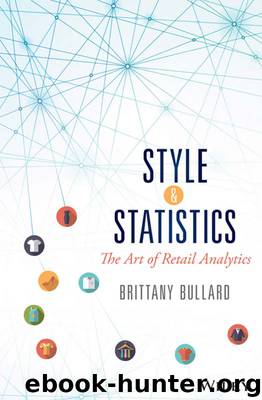Style and Statistics: The Art of Retail Analytics (Wiley and SAS Business Series) by Bullard Brittany

Author:Bullard, Brittany [Bullard, Brittany]
Language: eng
Format: epub
ISBN: 9781119271246
Publisher: Wiley
Published: 2016-11-21T16:00:00+00:00
MARKDOWN/CLEARANCE PRICING
As merchandise begins to age, there comes a point in the product life cycle where this inventory shifts from regular/promotional pricing to markdowns (or clearance). The typical fashion product has a life cycle of 8 to 12 weeks. Once this time period has elapsed, the inventory is marked down. Seasonal products, such as coats and holiday merchandise, are also marked down at the end of the season.
I always admire the people who stock up on Christmas merchandise right after the holiday when it is marked down. I never buy something that I am going to stick in my closet and wait a whole year to use, mainly because I move too often and fear becoming a hoarder. It may also be because my birthday is after Christmas, and I spend the time buying myself birthday clothes and planning parties.
But anyway . . . The movement of merchandise to clearance generally has been based on a product life cycle timing and to clearance at a total chain level. This means that items being moved or reduced to clearance are marked down in all stores and on the retailer’s website. Once it is determined that the items should be marked down, retailers leverage a markdown cadence, which refers to the determination of the schedule and price point of the initial clearance price as well as any additional price reductions. This cadence varies by retailer. Some use the same cadence across all products; others leverage a different markdown cadence by category. The initial markdown is also a component that may remain the same across the company.
So, for example, a retailer may determine that a product life cycle is eight weeks for a fashion item. After the item is in store for eight weeks, it is marked down to clearance, which for this retailer is 50% off the regular or ticket price. Two weeks after the initial markdown, the item is then reduced further to 60% off. After two weeks of being at 60% percent off, the item is reduced to 70% off. Two weeks later, the item is marked down to 80% off. In this example, the retailer is leveraging a markdown cadence across all fashion products with a four-cycle cadence: initial markdown of 50% off and subsequent cycles reducing in 10%-off increments.
Once all of the markdown cadences for an item have been exhausted, the product may be marked out of stock. At this point, the price for the product has been reduced so drastically that the retailer is losing money selling it. The selling price is actually lower than what the retailer paid for the item. Retailers try their hardest to avoid losing money. Some retailers actually donate items to charity once they have reached this point in the product life cycle. An item may end up at this particular point for many reasons. Perhaps the pricing strategy across the life cycle was not planned properly. This can occur if a retailer does not react quickly to underperformance. This could also
Download
This site does not store any files on its server. We only index and link to content provided by other sites. Please contact the content providers to delete copyright contents if any and email us, we'll remove relevant links or contents immediately.
Life 3.0: Being Human in the Age of Artificial Intelligence by Tegmark Max(5478)
The Sports Rules Book by Human Kinetics(4299)
The Age of Surveillance Capitalism by Shoshana Zuboff(4216)
ACT Math For Dummies by Zegarelli Mark(3996)
Unlabel: Selling You Without Selling Out by Marc Ecko(3591)
Blood, Sweat, and Pixels by Jason Schreier(3568)
Hidden Persuasion: 33 psychological influence techniques in advertising by Marc Andrews & Matthijs van Leeuwen & Rick van Baaren(3476)
The Pixar Touch by David A. Price(3369)
Bad Pharma by Ben Goldacre(3358)
Urban Outlaw by Magnus Walker(3342)
Project Animal Farm: An Accidental Journey into the Secret World of Farming and the Truth About Our Food by Sonia Faruqi(3178)
Kitchen confidential by Anthony Bourdain(3016)
Brotopia by Emily Chang(3002)
Slugfest by Reed Tucker(2944)
The Content Trap by Bharat Anand(2863)
The Airbnb Story by Leigh Gallagher(2800)
Coffee for One by KJ Fallon(2571)
Smuggler's Cove: Exotic Cocktails, Rum, and the Cult of Tiki by Martin Cate & Rebecca Cate(2474)
Beer is proof God loves us by Charles W. Bamforth(2376)
